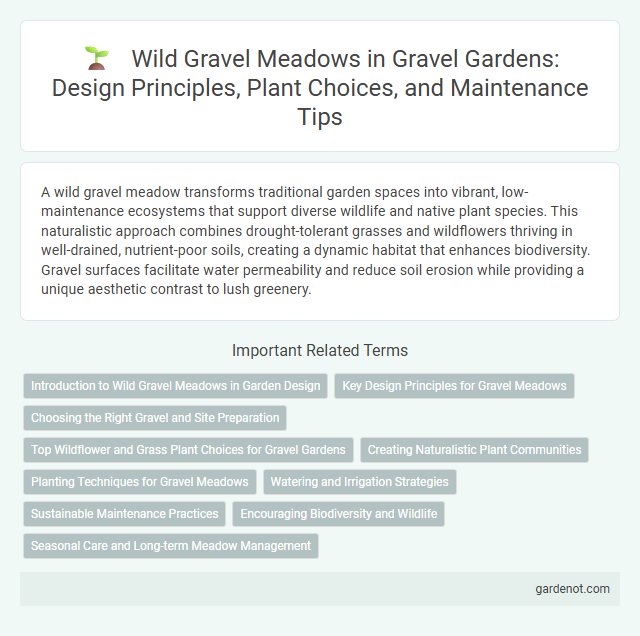A wild gravel meadow transforms traditional garden spaces into vibrant, low-maintenance ecosystems that support diverse wildlife and native plant species. This naturalistic approach combines drought-tolerant grasses and wildflowers thriving in well-drained, nutrient-poor soils, creating a dynamic habitat that enhances biodiversity. Gravel surfaces facilitate water permeability and reduce soil erosion while providing a unique aesthetic contrast to lush greenery.
Introduction to Wild Gravel Meadows in Garden Design
Wild gravel meadows enhance garden design by combining drought-tolerant plants with naturalistic aesthetics, promoting biodiversity and low-maintenance landscapes. Native grasses and wildflowers thrive in the porous, well-drained gravel substrate, creating a dynamic habitat for pollinators and beneficial insects. This sustainable gardening approach reduces water use and supports ecological balance in urban and suburban environments.
Key Design Principles for Gravel Meadows
Wild gravel meadows thrive by integrating native drought-tolerant plants that enhance soil permeability and minimize maintenance. Strategic layering of coarse gravel with finer substrates supports diverse root systems and promotes natural water drainage, crucial for meadow sustainability. Emphasizing organic patterns and native species selection creates resilient habitats that attract pollinators and bolster biodiversity within gravel garden designs.
Choosing the Right Gravel and Site Preparation
Selecting the right gravel for a wild gravel meadow involves choosing materials like crushed granite or limestone that promote proper drainage and support native plant growth. Site preparation requires removing existing vegetation, leveling the ground, and installing a weed barrier to ensure long-term weed control and optimal soil conditions. Properly prepared soil combined with the appropriate gravel enhances biodiversity and creates a sustainable, low-maintenance garden environment.
Top Wildflower and Grass Plant Choices for Gravel Gardens
Top wildflower and grass plant choices for gravel gardens include native species like Betonica officinalis (betony), Achillea millefolium (yarrow), and Festuca rubra (red fescue). These plants thrive in well-drained, low-nutrient soils typical of wild gravel meadows, promoting biodiversity and supporting pollinators. Selecting drought-tolerant, hardy varieties ensures year-round structure and color while minimizing maintenance in gravel garden designs.
Creating Naturalistic Plant Communities
Wild gravel meadows foster diverse, naturalistic plant communities by mimicking native habitats and promoting species adapted to well-drained, nutrient-poor soils. Integrating drought-tolerant perennials, native grasses, and wildflowers creates resilient ecosystems that support pollinators and enhance biodiversity. Strategic planting in gravel gardens encourages ecological balance and reduces maintenance while achieving a striking, sustainable landscape.
Planting Techniques for Gravel Meadows
Planting techniques for wild gravel meadows prioritize using native drought-tolerant species that thrive in well-drained, nutrient-poor soils. Seedbed preparation involves minimal soil disturbance to preserve the existing gravel substrate, promoting natural germination and root establishment. Strategic sowing of a diverse seed mix during early autumn enhances plant diversity and resilience in gravel garden ecosystems.
Watering and Irrigation Strategies
Wild gravel meadows thrive with minimal watering, relying on natural rainfall and well-draining soil to prevent waterlogging. Drip irrigation systems deliver targeted moisture directly to plant roots, conserving water and promoting healthy growth in drought-prone areas. Mulching around plants retains soil moisture, reduces evaporation, and supports drought-resistant species within the gravel garden ecosystem.
Sustainable Maintenance Practices
Wild gravel meadows promote biodiversity by supporting native flora and fauna adapted to nutrient-poor, well-drained soils. Sustainable maintenance practices emphasize minimal intervention, such as seasonal mowing after seed set and avoiding chemical fertilizers to preserve soil health and ecological balance. Integrating water-efficient irrigation and organic mulch enhances drought resilience while reducing resource consumption in gravel garden management.
Encouraging Biodiversity and Wildlife
Wild gravel meadows create diverse habitats by combining native wildflowers, grasses, and open soil patches that support pollinators, birds, and small mammals. These ecosystems promote biodiversity by providing food sources, nesting sites, and microclimates essential for various wildlife species. Maintaining a wild gravel meadow encourages natural ecological processes, enhancing soil health and resilience against pests and diseases.
Seasonal Care and Long-term Meadow Management
Seasonal care for a wild gravel meadow involves regular monitoring of soil moisture and selective weeding during early spring to support native flora. Long-term meadow management requires periodic mowing or grazing in late summer to prevent shrub encroachment and maintain biodiversity. Integrating controlled burns or scarification every few years promotes seed germination and habitat health, ensuring the meadow's ecological resilience.
Wild gravel meadow Infographic

 gardenot.com
gardenot.com